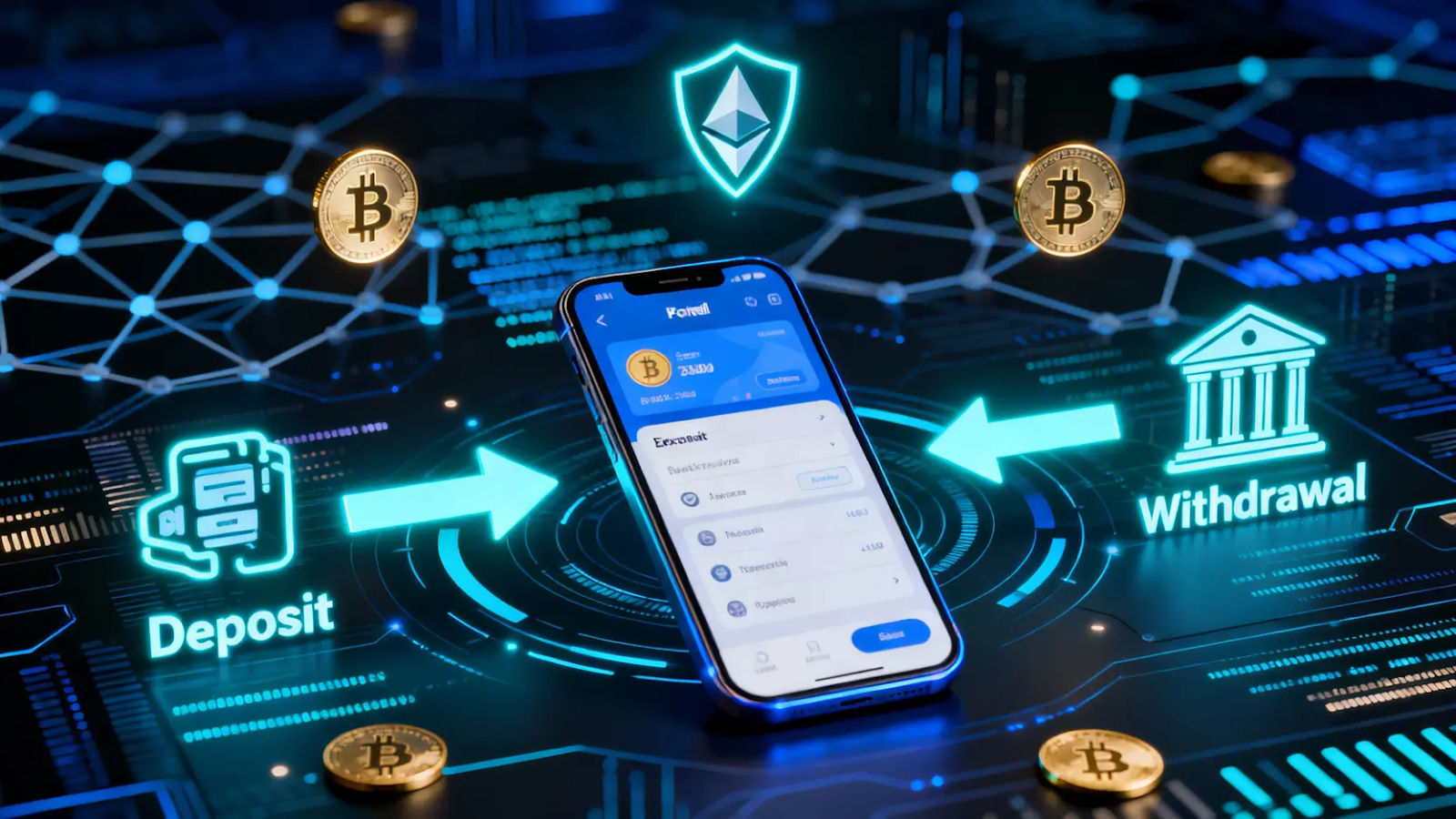2025 Beginner’s Guide to Exchange Transfers: TRC20 & ERC20 Explained
Exchange Fund Transfer Procedure: Illustrated Guide to Deposits, Withdrawals, and Wallet Transfers

New to the world of cryptocurrency but overwhelmed by the complicated fund operations? You often hear terms like “deposit”, “withdrawal”, and “fund transfer”, yet when it comes to actual operation, you worry that pressing the wrong button might cost you everything. This beginner-friendly guide to the exchange fund transfer procedure uses detailed illustrations to walk you through the complete process of exchange deposits, internal fund transfers, withdrawals to a bank account, and wallet transfer instructions, helping you manage your digital assets safely and efficiently.
Step 1: Exchange Deposit Guide (Putting Funds Into the Exchange)
“Deposit” is a common term in the crypto space, referring to transferring fiat currency (such as TWD or USD) or cryptocurrency into your exchange account so you can begin trading. This is the very first step of all operations, and choosing the method that suits you best is extremely important.
Method 1: TWD Deposit Process (Using the MAX Exchange as an Example)
For investors in Taiwan, using an exchange that supports TWD is the most intuitive and convenient deposit method. MAX Exchange is one of the mainstream choices in Taiwan, and its process is representative.
- Step 1: Complete bank account binding. To comply with financial regulations (KYC), you must first bind a bank account under your own name on the exchange. This ensures the legitimacy of your fund source and serves as the only path for future TWD withdrawals.
- Step 2: Obtain your dedicated deposit account. In the exchange’s “Deposit” or “Wallet” page, select “TWD”, and the system will provide a dedicated bank account for you.
- Step 3: Transfer funds from your bound account. Using the bank account you previously bound, transfer TWD to the dedicated account via online banking or ATM. Important: You must transfer from the bound account, otherwise the transfer will fail.
- Step 4: Confirm receipt. During bank business hours, transfers usually arrive within 10–30 minutes, and the exchange will notify you via email or app notification.
Method 2: Credit Card Crypto Purchase Deposit (Using Binance as an Example)
If you need to enter the market quickly or if the exchange you use does not support TWD, purchasing crypto with a credit card is a fast option, though the cost is relatively high. Binance, the world’s largest exchange, offers this service.
- Advantages: Fast, nearly instant, and very intuitive, similar to online shopping.
- Disadvantages: High fees, usually including exchange fees and credit card foreign transaction fees. The total cost may be 3–5% or even higher. In addition, some Taiwanese credit card issuers may block crypto-related transactions.
- Process: On the exchange homepage, find “Buy Crypto with Credit Card” or a similar entry, enter the amount you want to buy, select the cryptocurrency (typically USDT, BTC, or ETH), and complete the process by entering your credit card information.
Method 3: Deposit Cryptocurrency via Transfer From Another Wallet
This is also known as a “crypto-to-crypto deposit”. If you already hold cryptocurrency in another exchange or personal wallet, you can transfer it directly into your new exchange account.
- Go to the exchange’s “Deposit/Recharge” page: Select the cryptocurrency you want to transfer in, such as USDT.
- Select the network (chain): This is the most critical step! You must ensure that the sending wallet and the receiving exchange are using the exact same network. For example, both must be TRC20.
- Copy the deposit address: The exchange will generate a dedicated address for that cryptocurrency on the selected network.
- Paste the address and transfer from the sending wallet: In your source wallet or exchange, select “Withdraw/Send”, paste the address you copied, and after confirming once again that the network is correct, proceed with the transfer.
Step 2: Exchange Fund Transfer Procedure (Moving Funds Within the Exchange)
After successfully depositing, you may notice that although the money has arrived in the exchange, you cannot trade immediately. This is because most major exchanges store user funds in different functional accounts, and in this case, you need a “fund transfer”. This is a completely free and instant internal transfer operation.
Why Is Fund Transfer Necessary? (Spot, Futures, and Earn Accounts Explained)
To manage risk and distinguish different functions, exchanges typically set up the following types of accounts:
- Spot Account: Also called the “trading account”, this is used for regular crypto-to-crypto trading. The Bitcoin, Ethereum, etc. that you buy will be stored here.
- Futures/Derivatives Account: Dedicated to operating futures contracts and leveraged trading. Because leveraged trading carries higher risk, exchanges keep these funds separate.
- Earn/Staking Account: If you want to participate in the exchange’s savings, staking, or other earn products to generate passive income, you must transfer funds into this account.
- Funding Account: This is usually the first stop for external funds entering the exchange (such as fiat deposits or credit card crypto purchases), and it also handles payments for C2C transactions.
Therefore, after depositing TWD, the funds may first arrive in the “funding account”, and you need to manually transfer them to the “spot account” before you can start buying and selling cryptocurrency.
Illustrated Guide: How to Perform a Fund Transfer Within the Exchange
Although each exchange interface may differ slightly, the core logic is very similar:
- Find the “Transfer” entry: Usually on your “Assets” or “Wallet” overview page, there will be a clearly visible “Transfer” button.
- Select the source and destination accounts: For example, transferring from the “Funding Account” to the “Spot Account”.
- Select the currency and amount: Choose the currency you want to transfer (such as TWD or USDT) and enter the amount.
- Confirm execution: After clicking confirm, the funds will arrive instantly and the transfer is completely free.
Step 3: Exchange Withdrawal Process (Taking Your Funds Out)
When you take profit or need to use your funds, “withdrawal” refers to converting the digital assets in the exchange into fiat currency and transferring them to your personal bank account. This is the final step in cryptocurrency investing.
Process 1: Sell cryptocurrency for TWD and withdraw to your bank
This is the most common withdrawal method and is the reverse of the TWD deposit process:
- Sell cryptocurrency for TWD: In the exchange’s trading market, find trading pairs such as BTC/TWD or USDT/TWD, sell the cryptocurrency you hold, and convert it into a TWD balance.
- Go to the “Withdraw” page: In the “Wallet”, find TWD and click “Withdraw”.
- Select the bound bank account and enter the amount: Enter the amount you wish to withdraw, and the system will automatically display the bank account you previously bound.
- Security verification and confirmation: The exchange will require multiple verification steps such as a fund password, Google Authenticator code, or mobile SMS to ensure it is you performing the operation.
- Wait for bank processing: After submitting the request, the funds are usually deposited into your bank account within 1–2 working days.
Process 2: USD wire transfer withdrawal method
For users with overseas bank accounts or those needing to withdraw large amounts, some international exchanges (such as Kraken) offer USD wire transfer withdrawals. The advantage of this method is that it can handle larger sums, but the drawbacks are that the process is more cumbersome, slower (may require 3–7 working days), and will incur intermediary bank fees for international wire transfers.
Step 4: Wallet Transfer Guide (Sending Funds to Others or to Your Own Cold Wallet)
After learning how to move funds to and from exchanges, the next step is mastering “on-chain transfers”, meaning transferring cryptocurrency from one wallet address to another. This may be to send funds to a friend, pay for goods, or move assets into a more secure cold wallet for storage.
Important Things to Know Before Making an On-Chain Transfer: What Is a Network Type (TRC20, ERC20, BEP20)?
This is the most important and also the easiest part to make mistakes in the entire cryptocurrency transfer guide. The same cryptocurrency (for example, USDT stablecoin) can be issued and circulated on different blockchains, and these different blockchains are called “networks”. You must ensure that both the sending side and the receiving side use the same network; otherwise, the asset may be permanently lost.
- ERC20 (Ethereum network): This is the original and most widely used network. Its advantage is its large ecosystem, supported by nearly all wallets and exchanges; its disadvantages are slower speed and very high fees (Gas Fees) during network congestion.
- TRC20 (Tron network): Supported by the Tron blockchain. Its biggest advantages are extremely fast transfer speed and extremely low fees, sometimes even free, making it the first choice for small USDT transfers.
- BEP20 (Binance Smart Chain): A network developed by Binance. It is fast, low-cost, and widely used within the Binance ecosystem.
Golden rule for transfers: Before transferring, always confirm the cryptocurrency, the network type, and the wallet address with the recipient, missing any one of these may cause irreversible loss!
Detailed Steps for Copying a Wallet Address and Executing a Transfer
- Obtain the recipient address and network: Ask the recipient for the correct wallet address and the corresponding network type.
- Go to the “Withdraw” function in the exchange or wallet: Select the cryptocurrency you want to transfer out, such as USDT.
- Paste the address and select the network: Paste the full recipient address, then select the same network as the recipient (for example, TRC20). Most exchanges will estimate the transfer fee after you choose the network.
- Enter the amount and confirm: Enter the amount you want to transfer and check whether the actual received amount is reduced due to fees.
- Complete security verification: Enter all required security codes and submit the transfer request.
How Do You Confirm a Successful Transfer? Introduction to Using a Blockchain Explorer
After submitting a transfer, the exchange will generate a transaction ID called “TxID” or “Hash”. This is like the tracking number for your transfer on the blockchain. With this number, you can check the transaction progress on the corresponding network’s “blockchain explorer”.
- For TRC20 network use: TRONSCAN
- For ERC20 network use: Etherscan
- For BEP20 network use: BscScan
Simply paste the TxID into the search bar of the appropriate explorer and you will see detailed information about the transaction, including whether it has been confirmed, the sending and receiving addresses, the amount, and more, everything is fully transparent.
FAQ
Q: How long does it take for deposits or withdrawals in an exchange to arrive?
A: It depends on the method you use. TWD deposits/withdrawals: During bank business hours, usually completed within 15 minutes to 2 hours; delayed during holidays or system maintenance. Cryptocurrency transfers (crypto-to-crypto deposits): Speed depends on the congestion of the blockchain and the processing speed of the exchange, ranging from 5 minutes to 1 hour. Credit card purchases: Almost instantaneous.
Q: What if I choose the wrong network for a wallet transfer? Will the assets disappear?
A: This is a very serious operation error. In most cases, if the sending and receiving networks do not match (for example, sending from ERC20 to a TRC20 address), the assets will be permanently lost and cannot be recovered, because the address formats and underlying technologies of different blockchains are not compatible. This is why you must confirm the network multiple times before making a transfer. In rare cases, if you transfer to a large centralized exchange that supports both networks, you may try contacting customer service for assistance, but they often charge high fees and success is not guaranteed.
Q: How are fees calculated when transferring between different exchanges?
A: The fee is charged by the sending exchange (the one initiating the withdrawal) and has nothing to do with the receiving exchange. This fee is not earned by the exchange; it is paid to miners or validators on the blockchain as compensation for processing your transaction (also known as Gas Fee). The fee varies significantly depending on the “network type” you select. TRC20 is usually the cheapest, while ERC20 is the most expensive during network congestion.
Q: Why does my withdrawal request show “Under review” or “Suspended”?
A: This is usually due to the exchange’s risk control mechanisms. Possible reasons include: 1. You recently changed your password or security settings, and your account is temporarily locked for 24 hours. 2. Your account triggered risk control due to suspected unauthorized operation. 3. The network of the cryptocurrency you are withdrawing is undergoing an upgrade or maintenance. 4. You are a new user who has just made a large fiat deposit. If the waiting time is too long, it is recommended to contact the exchange’s customer service to inquire about the reason.
Conclusion
Mastering deposits, withdrawals, fund transfers, and wallet transfers on an exchange is a fundamental skill for navigating the crypto world smoothly. This article has fully explained the four major operational procedures, from the basics of exchange deposit tutorials to the most crucial wallet transfer instructions. As long as you follow the illustrated guide and develop the habit of double-checking the address and network before every transfer, you can avoid the vast majority of beginner mistakes. We hope this ultimate guide to exchange fund transfer procedures helps you manage your digital assets with greater confidence. Start your first deposit operation now!
Related Articles
-
Which Exchange Is Best for Beginners? 2025 Beginner’s Guide and Exchange Recommendations Just stepped into the new world of cryptocurrency but already overwhelmed by the countless exchanges out there? When faced with the big question, “Which exchange is best for beginners?”, many people simply don’t know where to start. In...2025 年 11 月 17 日
-
Exchange API Application and Integration Tutorial: Understand API Trading Settings in One Article! Tired of watching the market all day and placing orders manually, only to miss the best entry and exit points? Want to implement 24/7 automated trading strategies through programming but don’t know where to start? This article...2025 年 11 月 17 日
-
Forex Trading Strategy Guide: A Complete Analysis of 5 Major Mainstream Strategies to Maximize Returns with Forex Rebates! Want to step into the forex market but feel overwhelmed by the wide range of “forex trading strategies”? Worried that frequent trading will cause fees and spreads, the so-called “trading costs”, to...2025 年 11 月 17 日












